The Testament of Sherlock Holmes
The Testament of Sherlock Holmes is an adventure video game in the Sherlock Holmes series developed by Frogwares and distributed by Focus Home Interactive.[1] After being delayed from an original 2010 release,[3] the game was released in Europe on 20 September 2012 and in North America on 25 September 2012.[4]
| The Testament of Sherlock Holmes | |
|---|---|
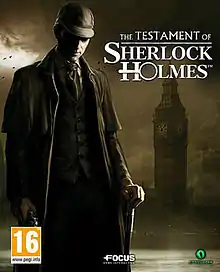 The Testament of Sherlock Holmes cover art | |
| Developer(s) | Frogwares |
| Publisher(s) | Focus Home Interactive[1] |
| Series | Sherlock Holmes |
| Platform(s) | Microsoft Windows, PlayStation 3, Xbox 360 |
| Release | |
| Genre(s) | Adventure |
| Mode(s) | Single-player |
The game was developed primarily for consoles, and features a new graphic engine and gameplay mechanics.[5] It is based on the fictional detective Sherlock Holmes, the protagonist of 56 short stories and 4 novels by Arthur Conan Doyle. Like many other games in the series, the game itself presents an original story and plot that is not based on any of Doyle's works. The Testament of Sherlock Holmes is set in the London of 1898, with Holmes presented as the main suspect in a case in which he is unable to prove his innocence.
Plot
In London, 1898, Holmes successfully solves a new case by retrieving a priceless set of jewels that had been stolen for Scotland Yard's new acting Inspector, Baynes. The following morning, a newspaper article accuses Holmes of the theft; Baynes arrives with the necklace, which is revealed as a cheap imitation. However, there is no solid evidence against Holmes, and Baynes says he will look into it further.
Holmes tells Watson he has an immediate appointment with the Bishop of Knightsbridge. Upon arriving, he discovers that the bishop has been tied up, burnt and mutilated, as well as a finger that presumably belongs to one of the murderers. Holmes deduces that the culprits had been low class workers, who had been hired and given a special poison that caused a form of psychotic madness. Upon further investigation, Holmes pinpoints the location where he believes the men to have worked, a cemetery in Whitechapel. The player is then given a choice where to go next. To visit the cemetery, or to a local prison which houses a poison manufacturer.
Wanting to learn more about the poisoning case, Holmes goes to the prison in order to interview Hans Scheilman, the Rat Killer. Holmes manages to get Scheilman what he wants in return for information on the poison. A fire begins in the cellblocks, causing confusion among the guards. Watson volunteers to help make sure the prisoners are still in their cells only to discover that Scheilman has escaped. Holmes and Watson leave, and wait out behind the prison, where Holmes claims to be meeting someone. Spotting a figure nearby, Watson realizes that Holmes helped Scheilman to escape. Watson is enraged that Holmes aided in the escape, while the latter insists that it was necessary, though he will not say why, yet. He tells Watson he will meet him at the next investigation.
Holmes meets Watson in Whitechapel the following morning, where Prince Woodville, an heir to the throne, is feeding the homeless and destitute. Holmes and Watson examine the cemetery and find directions to a house, which they follow, leading them to a deceased man, missing a finger, who was mauled by his dogs. They look around his apartment and find clues that indicate he was involved in the Bishop's murder. They also find opium paraphernalia. They perform an autopsy and discover that his opium had been laced with the same poison that had been used on the Bishop. They go to the nearby opium den and discover the other men involved in the murder, though they are apprehended by Scotland Yard. Holmes and Watson leave, despite Watson's protests.
Holmes wants to question the Bishop's nephew, Henry. They go to the address where he rents a room, and discover that someone had been watching the house. They check his room, and notice that he had left in a hurry, and even more worryingly, appears to be armed. They find clues that indicate he is laying low at the Wharf 321. Holmes heads to the Wharf, along with his dog, Toby, to track down Henry. He finds him within a smelting plant, however Henry holds Holmes at gunpoint, but is accidentally knocked into molten metal by Toby, killing him.
With the trail dead, Holmes decides to visit O'Farley, a journalist who had written a slanderous article accusing Holmes of the theft of the necklace. O'Farley rushes out when Holmes arrives. Holmes takes the opportunity to break into and search his office. Discovering that he seems intent on proving Holmes is a fraud, has information on Prince Woodville, and also had a visitor who left moments before Holmes arrived. Holmes discovers a secret exit that the visitor used, and he pieces together that the visitor is a judge. Holmes investigates clues to determine who the judge was, and discovers that it was Sir Coutes Beckett.
Holmes and Watson break into Beckett's house. Holmes leaves a mysterious package on Beckett's desk. They discover that Beckett has a collection of evidence against Holmes, making Watson suspicious. He and Holmes leave, though Watson spots Beckett and insists on talking to him. Holmes says that he is leaving, but Watson stays, and approaches the house, which suddenly explodes, causing Watson to be knocked out cold.
Holmes disappears, and is now wanted for questioning about the explosion. Watson is taken to Scotland Yard and questioned while the police ransack their Baker Street home. Watson returns, and looks for clues to figure out where Holmes went. The clues indicate that he is in disguise and hiding at a rented room in Whitechapel. Watson goes there and confronts Holmes, who is disguised as an old woman. Holmes tells Watson he is heading out of the city to continue the investigation.
They arrive at a sawmill, which is inhabited by three Russian anarchists, who seem to be representative of the three wise monkeys (One is blind, one is deaf, one is mute), who Watson holds up and questions while Holmes looks around upstairs, finding the body of a deceased magician who previously lived there. Holmes sets the place on fire, causing a panic among the brothers, who flee when Watson calls out to Holmes. One of the brothers warns that Sherlock Holmes is dangerous and shouldn't be trusted. Baynes and the police arrive to look for Holmes. Watson informs them Holmes is upstairs. Baynes goes after him alone and is soon thrown from the window. Holmes is branded a murderer and is hunted. Watson arrives at Baker Street, where he finds Holmes. After a brief stand off, Holmes shoots himself.
Needing closure, Watson continues the investigation, which leads him to the sewers, where he finds Holmes being beaten by two thugs. He frees Holmes, and they return to Baker Street. Holmes apologises to Watson for his behaviour and reveals that he needed to fake his death in order to continue the investigation unhindered. Holmes reveals everything he knows to Watson. Professor Moriarty has been plotting to cause panic by poisoning the poor of London, using the same poison used on the bishop, which is being mass-produced by Scheilman, by mixing it into the soup from Prince Woodville's soup carts. This would cause the poisoned people to riot and kill anyone in their way, and then eventually die themselves from the poison, which would result in the deaths of thousands. As well as this he planned on removing the queen from power. This would create mass hysteria and a massive power vacuum, which Moriarty would fill by putting Prince Woodville on the throne, who now had a great public image, giving Moriarty control over Woodville, and in turn the British Armed Forces. However, Moriarty knew that Holmes was the only one that could stop him, and then plotted to discredit Holmes and criminalize him. He recruited Baynes to temporarily replace Lestrade and prevent Holmes from finding out the truth, which included nabbing the two murderers at the opium den and forging documents to frame Holmes, eventually forcing Holmes to kill him. He also recruited the three Russian brothers to use their bomb making skills to take out Judge Beckett, when the latter was on the verge of discovering the documents were fake and was going to expose everything.
Holmes and Watson go to stop Moriarty's scheme, by going to his hideout, an old carnival near a disused and dilapidated factory, where the poisoned soup is being made. Holmes and Watson incapacitate the guards and continue their investigation. They discover the three Russian anarchists also have made bombs that will go off via radio transmitter, at key locations including Scotland Yard. While trying to find out how to disarm the bombs, they find Prince Woodville, who they tell they are working for Moriarty. Not believing them, he holds Watson at gun point and demands to bring Holmes to Moriarty. Holmes incapacitates Woodville and hides his body. Holmes and Watson split up, Holmes to call and warn Inspector Lestrade, who had returned after Bayne's death, about the bombs. He also learns that Moriarty is not in control and he is merely a puppet. Watson builds a bomb to better understand it, and figures out it must be disconnected from the radio tower before being disarmed. He returns to Holmes with this information, and his newly constructed bomb. After disconnecting the bombs from the radio transmitter, Holmes and Watson decide to use their bomb to destroy the factory producing the soup. They make their way there via cable car, which is stopped by Moriarty. Holmes and Watson send the bomb down the cable, causing it to detonate on the roof, killing several of Moriarty's henchmen and destroying the factory.
Holmes and Watson return to Moriarty's quarters to find out who was controlling Moriarty, who suddenly appears, badly burned by the explosion and brandishing a gun. Holmes casually asks if Scheilman was immune to his own poison. Suddenly, a feral Scheilman attacks Moriarty and savagely bites at his throat. Moriarty shoots him, but is too late to save himself. With his dying breath, Moriarty, asks Holmes to take care of his daughter, as he is the only one worthy to teach her. Holmes takes the child and treats her as his own, giving her an education and new life. In turn, he finally has a family of his own.
Gameplay

The player takes the role of Sherlock Holmes for the majority of the game, though there are also sections in which they control Dr. Watson and one where Toby, a basset hound, is controlled. The majority of the game involves exploring crime scenes and examining clues. An ability called 'sixth sense' is available, which will briefly highlight all the objects which can be interacted with in the player's field of view; this ability must then be allowed to recharge before it can be used again. Once discovered, clues are added to a 'deduction board', a gameplay mechanic which involves linking pieces of information and select from a number of possible deductions. Once all clues are discovered and the correct deductions selected, the story progresses. There are also several puzzles which must be solved, most of which take the form of locked puzzle boxes.
Three camera views are available – a first person point of view, an over-the-shoulder camera and a static third person camera. The player is able to change between them at any time. The Testament of Sherlock Holmes is also the first game in the Sherlock Holmes series to support the use of a gamepad. Dialogue and documents which have been discovered are stored for the player to review.
Development
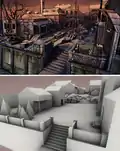
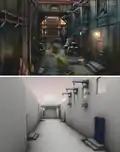
After the release of the ported Sherlock Holmes Versus Jack the Ripper, Frogwares and French publisher Focus Home Interactive got feedback from console players in particular that they wanted more adventure games with 3D graphics and production values to match what other genres are offering. Frogwares admitted to be eager in delivering one, though Waël Amr, the CEO, insists this does not mean forgetting about PC players, as some already speculated.[6] The development of the game took nearly three years to complete.[7]
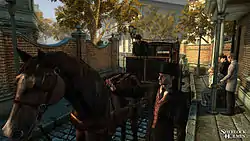
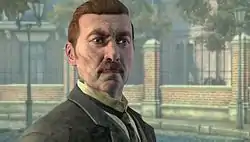
Waël Amr explains that in the past, the team has always been limited in reaching the PC market by trying to aim for a middle ground with PC owners, so that the specs have been lowered to match the greater share of the market. With this latest game being developed with the then current generation of consoles in mind, the development team was able to focus on polishing the graphics and creating the adventure game they'd always wanted to.[8]
The previous game in the series, Sherlock Holmes versus Jack the Ripper, was ported to console, but was simply a conversion. Rather than being ported from a PC version of the title, the team developed the title specifically for Xbox 360 and PlayStation 3 for the first time.[9]
Sherlock Holmes versus Jack the Ripper used drawings to depict its murder victims, hiding the full horror of the scenes out of respect for the real historical victims. Frogwares in the new title approaches on more mature and graphic moments. As the characters here are purely fictional, there is no restraint in showing the gory scenes.
With this, they first upgraded the graphics, and was first previewed in the screenshots. These images were released by Frogwares to every gaming website, most notably GameSpot and IGN. The first of these were posted on February 2011, and more surfaces the following months.[10] After the release of the first trailer and gameplay in E3 2011, Frogwares later released 4 more trailers with gameplay footage, with one more still to be released.[11] The fourth trailer was shown in E3 2012.[12] Destructoid and AdventureGamers.com were the first to play the game's demo.[13] These demos where later posted in GameSpot's Daily Demo, where two gameplay missions were posted in YouTube.[14] Wael also presented the game in Gameswelt and GotGame.com, entertaining with interviews about gameplay mechanics and the team's development timeline.[7][15]
These upgrades were said to be a part of a broader move to attract more console players. This does, however, coincide with a change in Frogwares approach to difficulty. Previously, insanely difficult puzzles were once considered a good thing, and success was measured in how long it took people to finish the game. As of what Waël observed about, they were carefully watching the internet, counting the days until people started posting complete solutions. They admitted later on, this was a "stupid" approach, and put emphasis on accessibility and not getting stuck in the same place for too long.[16]
With the trailer shown in the E3 2011, Wael confirmed that the game would show Holmes' darker side, where he now uses blackmail, forgery, and isolation in exile away from society. Saying that, Holmes now relies on his survival skills and street-smart, paired in a cat-and-mouse style plot widely seen in other games such as Tom Clancy's Splinter Cell: Conviction and Robert Ludlum's The Bourne Conspiracy.[17]
In April 2011, developer Frogwares announced plans to release the game at an earlier stage. At the time the game was targeted for the Autumn of 2011. A post on Frogwares' Facebook page confirmed the game was due for release at the end of 2011.[3] However, the game ended up being pushed back for release in 2012. Frogware's then officially revealed the release date of the game as 20 September 2012.
Atlus announced at E3 2012 that it has obtained the North American publishing rights for the game.[18]
Reception
| Aggregator | Score |
|---|---|
| Metacritic | PC: 73/100[19] PS3: 65/100[20] X360: 64/100[21] |
The game received mostly positive reviews. GameSpot awarded it 8.0 out of ten and said "Even with the minor issues with pixel hunts and puzzle overloading, this is an uncompromising, riveting adventure game".[22] Game Informer awarded it 7.50 out of ten and said "True to his past exploits, Holmes' newest case provides an intriguing mystery to unravel, despite still falling for some common adventure game pitfalls".[23]
The game was awarded "Best of the Rest" in the Honorary Aggie Award category by the website Adventure Gamers, saying that "the surprising story of Sherlock's apparent fall from grace was thoroughly engaging right from the start and kept the momentum up through well-crafted characters and plenty of twists and turns. Topped off with stunning visuals and an impressive orchestral soundtrack, this was Frogwares at their finest."[24]
References
- Legally, Focus Home Interactive was not a publisher but a licensee (distribution intermediary) "It needs to be clear it wasn’t a “developer and publisher” situation" (Waël Amr), Planète Aventure, 22 February 2020.
- "The Testament of Sherlock Holmes release dates". Official Website. 1 September 2012. Retrieved 1 September 2012.
- "The Testament of Sherlock Holmes delayed to late 2011". News.bigdownload.com. 17 November 2010. Archived from the original on 8 August 2011. Retrieved 29 August 2011.
- "Crimes & Punishments - Sherlock Holmes". Sherlockholmes-thegame.com. Retrieved 18 May 2015.
- "Sherlock Holmes". Sherlockholmes-thegame.com. Archived from the original on 24 April 2012. Retrieved 28 August 2011.
- "First insight on Frogwares". Adventure Gamers. 17 November 2010. Retrieved 29 August 2011.
- "YouTube". YouTube. Archived from the original on 2 February 2016. Retrieved 18 May 2015.
- "First insight on Frogwares". Destructoid.com. 17 November 2010. Retrieved 1 October 2011.
- "First insight on the game". 17 November 2010. Retrieved 29 August 2011.
- "Game screenshots". GameSpot. 17 November 2010. Archived from the original on 7 July 2012. Retrieved 29 August 2011.
- "Official Website". Official Website. 17 November 2010. Retrieved 29 August 2011.
- "E3 Game Trailer". GameSpot. 17 November 2010. Archived from the original on 11 June 2012. Retrieved 29 August 2011.
- "First look: The Testament of Sherlock Holmes". Destructoid.com. 29 September 2011. Retrieved 18 May 2015.
- "GameSpot's Daily Demo". GameSpot. 17 November 2010. Retrieved 29 August 2011.
- "YouTube". YouTube. Retrieved 18 May 2015.
- Harald Bastiaanse (17 November 2010). "First insight on Frogwares". Adventure Gamers. Archived from the original on 18 September 2011. Retrieved 29 August 2011.
- "E3 Walkthrough". GameTrailers. 17 November 2010. Retrieved 29 August 2011.
- "Gamasutra article of The Testament of Sherlock Holmes". Gamasutra. 17 November 2010. Retrieved 29 August 2011.
- "The Testament of Sherlock Holmes for PC Reviews". Metacritic. Retrieved 7 April 2020.
- "The Testament of Sherlock Holmes for PlayStation 3 Reviews". Metacritic. Retrieved 7 April 2020.
- "The Testament of Sherlock Holmes for Xbox 360 Reviews". Metacritic. Retrieved 7 April 2020.
- "The Testament of Sherlock Holmes Review". GameSpot. 27 September 2012. Archived from the original on 31 October 2012. Retrieved 1 November 2012.
- "Another Solid Case for the Great Sherlock Holmes - The Testament of Sherlock Holmes - PlayStation 3". Game Informer. 26 September 2012. Retrieved 18 May 2015.
- "Aggie Awards 2012". Adventure Gamers. 25 March 2012. Retrieved 25 March 2012.
External links
| Wikimedia Commons has media related to The Testament of Sherlock Holmes. |
- Official website
- The Testament of Sherlock Holmes Original Soundtrack at MusicBrainz (list of releases)